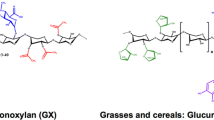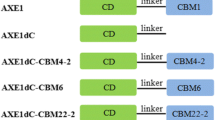Abstract
The genome of the coprophilous fungus Podospora anserina displays an impressive array of genes encoding hemicellulolytic enzymes. In this study, we focused on a putative carbohydrate esterase (CE) from family 16 (CE16) that bears a carbohydrate-binding module from family CBM1. The protein was heterologously expressed in Pichia pastoris and purified to electrophoretic homogeneity. The P. anserina CE16 enzyme (PaCE16A) exhibited different catalytic properties than so far known CE16 esterases represented by the Trichoderma reesei CE16 acetyl esterase (TrCE16). A common property of both CE16 esterases is their exodeacetylase activity, i.e., deesterification at positions 3 and 4 of monomeric xylosides and the nonreducing end xylopyranosyl (Xylp) residue of oligomeric homologues. However, the PaCE16A showed lower positional specificity than TrCE16 and efficiently deacetylated also position 2. The major difference observed between PaCE16A and TrCE16 was found on polymeric substrate, acetylglucuronoxylan. While TrCE16 does not attack internal acetyl groups, PaCE16A deacetylated singly and doubly acetylated Xylp residues in the polymer to such an extent that it resulted in the polymer precipitation. Similarly as typical acetylxylan esterases belonging to CE1, CE4, CE5, and CE6 families, PaCE16A did not attack 3-O-acetyl group of xylopyranosyl residues carrying 4-O-methyl-d-glucuronic acid at position 2. PaCE16A thus represents a CE16 member displaying unique catalytic properties, which are intermediate between the TrCE16 exodeacetylase and acetylxylan esterases designed to deacetylate polymeric substrate. The catalytic versatility of PaCE16A makes the enzyme an important candidate for biotechnological applications.






Similar content being viewed by others
References
Alalouf O, Balazs Y, Volkinshtein M, Grimpel Y, Shoham G, Shoham Y (2011) A new family of carbohydrate esterases is represented by a GDSL hydrolase/acetylxylan esterase from Geobacillus stearothermophilus. J Biol Chem 286:41993–42001. doi:10.1074/jbc.M111.301051
Appeldoorn MM, de Waard P, Kabel MA, Gruppen H, Schols HA (2013) Enzyme resistant feruloylated xylooligomer analogues from thermochemically treated corn fiber contain large side chains, ethyl glycosides and novel sites of acetylation. Carbohydr Res 381:33–42. doi:10.1016/j.carres.2013.08.024
Biely P, Côté GL, Kremnický Ľ, Weisleder D, Greene RV (1996) Substrate specificity of acetylxylan esterase from Schizophyllum commune: mode of action on acetylated carbohydrates. Biochim Biophys Acta 1298:209–222. doi:10.1016/S0167-4838(96)00132-X
Biely P, Hirsch J, la Grange DC, van Zyl WH, Prior BA (2000) A chromogenic substrate for a β-xylosidase-coupled assay of α-glucuronidase. Anal Biochem 286:289–294. doi:10.1006/abio.2000.4810
Biely P, Cziszárová M, Agger JW, Li X-L, Puchart V, Vršanská M, Eijsink VGH, Westereng B (2014a) Trichoderma reesei CE16 acetyl esterase and its role in enzymatic degradation of acetylated hemicellulose. Biochim Biophys Acta 1840:516–525. doi:10.1016/j.bbagen.2013.10.008
Biely P, Westereng B, Puchart V, de Maayer P, Cowan DA (2014b) Recent progress in understanding the mode of action of acetylxylan esterases. J Appl Glycosci 61:35–44. doi:10.5458/jag.jag.JAG-2013_018
Bischof R, Fourtis L, Limbeck A, Gamauf C, Seiboth B, Kubicek CP (2013) Comparative analysis of the Trichoderma reesei transcriptome during growth on the cellulase inducing substrates wheat straw and lactose. Biotechnol Biofuels 6:127. doi:10.1186/1754-6834-6-127
Bounias M (1980) N-(1-Naphthyl)ethylenediamine dihydrochloride as a new reagent for nanomole quantification of sugars on thin-layer plates by a mathematical calibration process. Anal Biochem 106:291–295. doi:10.1016/0003-2697(80)90523-0
Bouveng HO, Garegg PJ, Lindberg B (1960) Positions of O-acetyl groups in birch xylan. Acta Chem Scand 14:742–748. doi:10.3891/acta.chem.scand.14-0742
Bradford MM (1976) A rapid and sensitive method for the quantitation of microgram quantities of protein utilizing the principle of protein-dye binding. Anal Biochem 72:248–254. doi:10.1016/0003-2697(76)90527-3
Busse-Wicher M, Gomes TCF, Tryfona T, Nikolovski N, Syott K, Grantham NJ, Bolam DN, Skaf MS, Dupree P (2014) The pattern of xylan acetylation suggests xylan may interact with cellulose microfibrils as a twofold helical screw in the secondary plant cell wall of Arabidopsis thaliana. Plant J 79:492–506. doi:10.1111/tpj.12575
Couturier M, Haon M, Coutinho PM, Henrissat B, Lesage-Meessen L, Berrin J-G (2011) Podospora anserina hemicellulases potentiate the Trichoderma reesei secretome for saccharification of lignocellulosic biomass. Appl Environ Microbiol 77:237–246. doi:10.1128/AEM.01761-10
Espagne E, Lespinet O, Malagnac F, Da Silva C, Jaillon O, Porcel BM, Couloux A, Aury J-M, Ségurens B, Poulain J, Anthouard V, Grossetete S, Khalili H, Coppin E, Déquard-Chablat M, Picard M, Contamine V, Arnaise S, Bourdais A, Berteaux-Lecellier V, Gautheret D, de Vries RP, Battaglia E, Coutinho PM, Danchin EGJ, Henrissat B, Khoury REL, Sainsard-Chanet A, Boivin A, Pinan-Lucarré B, Sellem CH, Debuchy R, Wincker P, Weissenbach J, Silar P (2008) The genome sequence of the model ascomycete fungus Podospora anserina. Genome Biol 9: art. R77. doi: 10.1186/gb-2008-9-5-r77
Häkkinen M, Arvas M, Oja M, Aro N, Penttilä M, Saloheimo M, Pakula TM (2012) Re-annotation of the CAZy genes of Trichoderma reesei and transcription in the presence of lignocellulosic substrates. Microb Cell Fact 11:art. 134. doi:10.1186/1475-2859-11-134
Hakulinen N, Tenkanen M, Rouvinen J (2000) Three-dimensional structure of the catalytic core of acetylxylan esterase from Trichoderma reesei: insights into the deacetylation mechanism. J Struct Biol 132:180–190. doi:10.1006/jsbi.2000.4318
Koutaniemi S, van Gool MP, Juvonen M, Jokela J, Hinz SW, Schols HA, Tenkanen M (2013) Distinct roles of carbohydrate esterase family CE16 acetyl esterases and polymer-acting acetyl xylan esterases in xylan degradation. J Biotechnol 168:684–692. doi:10.1016/j.jbiotec.2013.10.009
Kremnický L, Biely P (2005) Unique mode of acetylation of oligosaccharides in aqueous two-phase system by Trichoderma reesei acetyl esterase. J Mol Catal B Enzym 37:72–78. doi:10.1016/j.molcatb.2005.09.011
Kremnický L, Mastihuba V, Côté GL (2004) Trichoderma reesei acetyl esterase catalyzes transesterification in water. J Mol Catal B Enzym 30:229–239. doi:10.1016/j.molcatb.2004.05.007
Li X-L, Skory CD, Cotta MA, Puchart V, Biely P (2008) Novel family of carbohydrate esterases, based on identification of the Hypocrea jecorina acetyl esterase gene. Appl Environ Microbiol 74:7482–7489. doi:10.1128/AEM.00807-08
Lombard V, Golaconda Ramulu H, Drula E, Coutinho PM, Henrissat B (2014) The carbohydrate-active enzymes database (CAZy) in 2013. Nucleic Acids Res 42:D490–D495. doi:10.1093/nar/gkt1178
Mastihubová M, Biely P (2004) Lipase-catalysed preparation of acetates of 4-nitrophenyl β-D-xylopyranoside and their use in kinetic studies of acetyl migration. Carbohydr Res 339:1353–1360. doi:10.1016/j.carres.2004.02.016
Navarro D, Rosso M-N, Haon M, Olivé C, Bonnin E, Lesage-Meessen L, Chevret D, Coutinho PM, Henrissat B, Berrin J-G (2014) Fast solubilization of recalcitrant cellulosic biomass by the basidiomycete fungus Laetisaria arvalis involves successive secretion of oxidative and hydrolytic enzymes. Biotechnol Biofuels 7: art. 143. doi:10.1186/s13068-014-0143-5
Neumüller KG, Carvalho de Souza A, Rijn JHJ, Streekstra H, Gruppen H, Schols HA (2015) Positional preferences of acetyl esterases from different CE families towards acetylated 4-O-methyl glucuronic acid-substituted xylo-oligosaccharides. Biotechnol Biofuels 8: art. 7. doi:10.1186/s13068-014-0187-6
Poidevin L, Berrin J-G, Bennati-Granier C, Levasseur A, Herpoël-Gimbert I, Chevret D, Coutinho PM, Henrissat B, Heiss-Blanquet S, Record E (2014) Comparative analyses of Podospora anserina secretomes reveal a large array of lignocellulose-active enzymes. Appl Microbiol Biotechnol 98:7457–7469. doi:10.1007/s00253-014-5698-3
Poutanen K, Sundberg M (1988) An acetyl esterase of Trichoderma reesei and its role in the hydrolysis of acetyl xylans. Appl Microbiol Biotechnol 28:419–424. doi:10.1007/BF00268207
Puchart V, Biely P (2015) Redistribution of acetyl groups on the non-reducing end xylopyranosyl residues and their removal by xylan deacetylases. Appl Microbiol Biotechnol 99:3865–3873. doi:10.1007/s00253-014-6160-2
Tamura K, Stecher G, Peterson D, Filipski A, Kumar S (2013) MEGA6: molecular evolutionary genetics analysis version 6.0. Mol Biol Evol 30:2725–2729. doi:10.1093/molbev/mst197
Uhliariková I, Vršanská M, McCleary BV, Biely P (2013) Positional specificity of acetylxylan esterases on natural polysaccharide: an NMR study. Biochim Biophys Acta 1830:3365–3372. doi:10.1016/j.bbagen.2013.01.011
Acknowledgments
Mrs. Mária Cziszárová and Dr. Iveta Uhliariková are gratefully acknowledged for their excellent technical assistance and NMR spectroscopy measurements. This work was supported by the Slovak Research and Development Agency under the contract No. APVV-0602-12 and by Scientific Grant Agency under the contract No. 2/0037/14. This work was also supported by the Research and Development Operation Programme funded by the European Regional Development Fund (ITMS 26220120054) and by SP Grant 2003SP200280203. This study was also funded by the French National Research Agency (A*MIDEX project ANR-11-IDEX-0001-02; ANR FUNLOCK ANR-13-BIME-0002-01).
Conflict of interest
The authors declare that they have no competing interests.
Author information
Authors and Affiliations
Corresponding author
Electronic supplementary material
Below is the link to the electronic supplementary material.
ESM 1
(PDF 835 kb)
Rights and permissions
About this article
Cite this article
Puchart, V., Berrin, JG., Haon, M. et al. A unique CE16 acetyl esterase from Podospora anserina active on polymeric xylan. Appl Microbiol Biotechnol 99, 10515–10526 (2015). https://doi.org/10.1007/s00253-015-6934-1
Received:
Revised:
Accepted:
Published:
Issue Date:
DOI: https://doi.org/10.1007/s00253-015-6934-1




